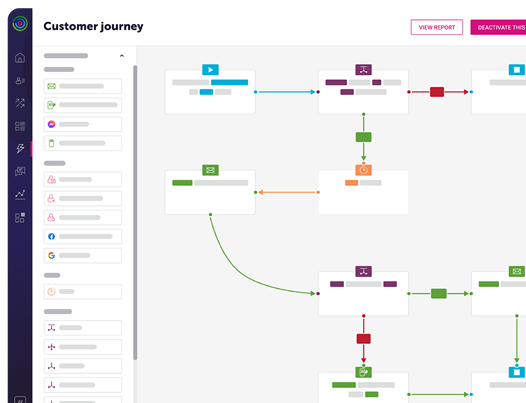Reach all your customers on their favorite channels
A broad range of channel touchpoints is essential for brands looking to connect with always-on consumers.
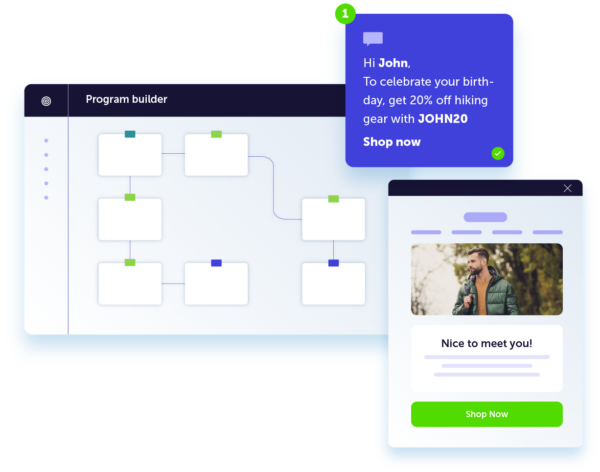
Build 1:1 connections at scale
Implementing cross-channel marketing has never been so easy. Trigger personalized website content, email, SMS, WhatsApp, and social messages across the customer journey.
Cross-channel marketing simplified
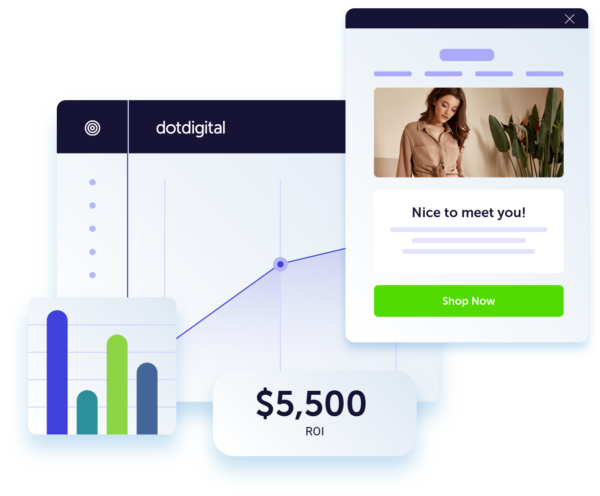
The backbone of every cross-channel journey
Designing eye-catching emails is easy with our intuitive email editor. Turn your customer data into emails that convert using product recommendations and dynamic content.

Get noticed on your customer’s favourite device
SMS works perfectly alongside email in any automated journey designed to drive conversions. Start sending in seconds with one click email-to-SMS support from WinstonAI.

Build deeper customer relationships
Take your 1:1 marketing to the next level with two-way conversations that lead to better outcomes. 71% of adults are more likely to buy from a brand they can contact via messaging.

Turn visitors into meaningful connections
Create personalized website experiences that convert. Dynamically display content tailored in real-time based on a visitor’s unique behavior, preferences, location, or weather.

Grow, convert, and retain more with retargeting
Acquire and convert customers using our social audience and messaging connectors. Automatically push your most engaged audiences from Dotdigital out to Facebook and Google to see your conversions soar.
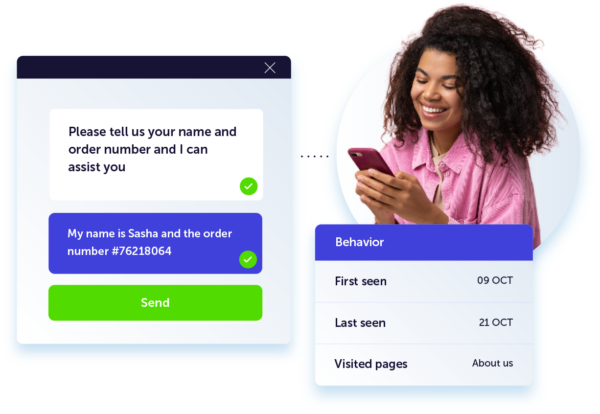
Break down barriers on the path to conversion
Live chat is proven to increase customer satisfaction and build better relationships. Your chat agents can access relevant customer insight to create more seamless customer experiences.
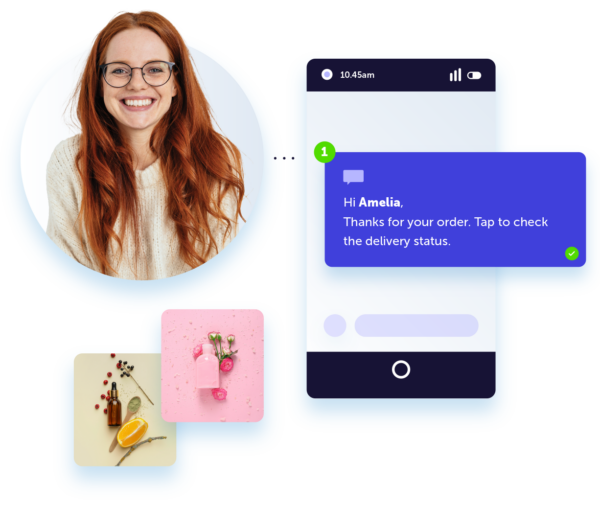
Stay top-of-mind with timely push notifications
Capture attention with time-sensitive messages. Deliver impeccably timed mobile app push notifications triggered by customer behavior or designed to complement your campaign goals.
Frequently asked questions
What is cross-channel marketing?
Cross-channel marketing is a customer-centric approach that leverages multiple marketing channels to deliver a unified and consistent brand experience across the entire customer journey. This includes channels like email, SMS, social media, WhatsApp, live chat and push notifications. By seamlessly blending these touchpoints, marketers can create personalized marketing campaigns that resonate with their target audience and drive conversions.
What is a cross-channel marketing platform?
A cross-channel marketing platform is a unified software solution that streamlines the management of all your marketing activities across various channels. With a cross-channel marketing platform, you can:
- Plan and execute campaigns: Schedule and launch marketing initiatives across email, SMS, social media, WhatsApp, live chat, and more, all from a single platform.
- Personalize the customer experience: Segment your audience based on demographics, behavior, and preferences to deliver targeted messaging that resonates with each individual.
- Measure and analyze results: Gain valuable data insights on campaign performance, allowing you to optimize your strategy and maximize ROI.
Think of a cross-channel marketing platform as your mission control center for crafting cohesive customer journeys and boosting your marketing success across all digital channels.
What are marketing channels?
Marketing channels are the various platforms and methods marketers use to reach and engage their target audience. Here are some of the most common digital marketing channels:
- Email marketing: Build relationships and promote products or services through targeted email campaigns.
- SMS marketing: Send quick, personalized text messages directly to your audience's mobile devices for alerts, promotions, and reminders.
- Social media marketing: Build brand awareness, engage audiences with interactive content, and drive traffic to your website through platforms like Facebook, Instagram, X, etc.
- WhatsApp messaging: Connect with your audience using the popular messaging app to send timely updates, promotions, and personalized customer support.
- Live chat: Offer real-time assistance and support to your website visitors, improving their experience and increasing the chances of conversion.
- Push notifications: Send instant updates, reminders, or promotions to your audience's devices, even when they are not actively using your website or app, to maintain engagement and drive action.
By strategically integrating these marketing channels, you can create a well-rounded online marketing presence that reaches your target audience across various touchpoints.
Why is cross-channel marketing important?
Modern-day customers interact with multiple touchpoints before making a purchase. In addition, customer expectations are on the rise, and they demand a customized and seamless experience. To stay relevant, brands need to engage with customers through multiple channels and create a consistent brand message across all these touchpoints. This will help create a memorable and impactful customer journey, increase brand awareness, foster trust, and ultimately drive conversions and sales.
What are the benefits of cross-channel marketing?
Cross-channel marketing offers numerous benefits that drive customer engagement and enhance business growth. Here's a breakdown of some key advantages:
- Higher ROI: Cross-channel marketing drives conversions, reduces customer acquisition costs, and enhances customer lifetime value, leading to greater returns on investment and overall business success.
- Unified customer journey: Cross-channel marketing fosters a comprehensive and positive experience for customers across all touchpoints, ensuring consistency and coherence throughout their journey.
- Increased brand awareness: By leveraging multiple channels, businesses can reach a wider audience and maximize brand visibility, creating lasting impressions and recall.
- Personalized marketing: Delivering tailored content based on customer data and preferences leads to deeper engagement, greater satisfaction, and higher conversion rates.
- Targeted outreach: Reaching the right audience at the right time with relevant messages across diverse channels optimizes campaign performance, ensuring marketing efforts are efficient and impactful.
- Data-driven insights: Analyzing data from various channels provides valuable insights that enable continuous improvement in messaging, targeting, and overall campaign optimization, ultimately driving better results.
What is a cross-channel marketing strategy?
A well-defined cross-channel marketing strategy is a roadmap for achieving specific business goals by leveraging a combination of digital marketing channels. Here are the key steps involved:
1. Target audience definition: Identify your ideal customer's demographics, online behavior, and preferred communication channels.
2. Channel selection: Analyze which digital channels (email, SMS, social media, live chat, etc.) best reach your target audience and align with your overall marketing objectives.
3. Consistent messaging: Develop a unified brand voice and messaging that resonates across all chosen channels, ensuring brand consistency.
4. Seamless channel integration: Create a smooth transition between channels as customers navigate their journey, fostering a cohesive experience.
5. Performance measurement: Track campaign results using key metrics and leverage data insights to continuously optimize your strategy for better performance.
By implementing a data-driven cross-channel marketing strategy, businesses can create a powerful and impactful customer experience across all touchpoints, ultimately driving brand loyalty, increased sales, and a higher ROI.
What is an example of cross-channel marketing?
There are many ways you can employ cross-channel marketing across your marketing strategy. Let’s look at an example:
Scenario: A travel agency aims to promote a new summer adventure package to a national park.
Cross-channel integration
- Social media campaign: Launch captivating video ads on Facebook that showcase the breathtaking beauty of the national park. Use Facebook Lead Ads to capture email addresses from potential travelers directly within the platform. Captured lead data seamlessly flows into the Dotdigital CXDP for further nurturing. This will set the stage for a personalized and engaging customer journey.
- Email marketing: Enroll your customers into a targeted welcome program based on the ad that drove their conversion For example, if your customer is a hiking enthusiast in hiking send emails highlighting relevant features of the park like the best trails. Personalized content with a clear call to action (CTA) directing the subscriber to a dedicated landing page on the agency's website increases engagement and keeps potential customers interested.
- Landing page: Your landing page should be filled with compelling information about the package, high-quality visuals, and clear CTAs. Adding an incentivized SMS subscription form to this page allows you to collect mobile numbers for stronger cross-channel engagement.
- SMS marketing: Deliver exclusive discounts, early access offers, or itinerary updates can be sent via SMS messages. These messages provide value and a sense of urgency, driving conversions towards booking the package.
- Retargeting: For those who visit the landing page but haven't booked yet, inactivity can trigger retargeting ads on social media platforms. These ads can showcase user-generated content from past park visitors, highlight customer testimonials, or emphasize other enticing package features to nudge them towards making a decision.
By using a combination of these channels with consistent messaging and targeted content, the travel agency creates a seamless and personalized customer journey. This ultimately increases bookings for their summer adventure package and demonstrates the power of a well-executed cross-channel marketing strategy.
What is the difference between cross-channel marketing, omnichannel, and multi-channel marketing?
While all three approaches aim to reach customers through various channels, they differ in their
level of integration and customer experience:
1. Cross-channel marketing
- Definition: A unified customer experience across all channels.
- Focus: Delivering a consistent and integrated brand experience across different touchpoints. - Integration: By integrating channels and sharing data, you gain a complete unified data view of the customer. This allows for highly personalized messaging and recommendations across the customer journey.
- Customer experience: Feels cohesive and personalized as messaging and customer experience is consistent across channels.
2. Multi-channel marketing
- Definition: Utilizes multiple separate channels like email, social media, website, etc., to reach customers.
- Focus: Reaching a wider audience and increasing brand exposure.
- Integration: Channels function independently with minimal communication or data exchange.
- Customer experience: May feel disjointed and inconsistent as messaging across channels might not be unified.
3. Omnichannel marketing
- Definition: Consistent customer experience across all channels online and offline.
- Focus: Providing consistent brand experience regardless of the touchpoint.
- Integration: Channels are fully integrated and interconnected.
- Customer experience: Feels seamless and personalized as the brand experience is consistent.
By understanding these distinctions, you can choose the marketing approach that best aligns with your goals and resources. For a deeper dive into these marketing channels, check out our comprehensive guide on cross-channel, omnichannel, and multi-channel marketing.
What is an example of cross-channel personalization?
Imagine you're browsing an online clothing store. You find a few styles you like, but get sidetracked and leave without buying anything.
This is where cross-channel personalization comes in. It uses customer data collected across different touchpoints to deliver a more relevant and engaging shopping experience.
Here's how the clothing store might use cross-channel personalization to win you back:
- Email: Shortly after you leave the site, you receive a personalized, triggered email using product recommendations of the clothes you browsed. It might even suggest similar styles or complementary items.
- Social media retargeting: You start seeing ads for those same items on Facebook or Instagram. These retargeting ads are based on your website browsing behavior, reminding you of the items you looked at.
- Website popover: On your next visit to the clothing store's website, a popover appears offering a discount code on clothes. This incentive is based on your previous browsing activity.
Overall, this experience keeps your brand top of mind and drives potential customers to convert.
How can cross-channel marketing increase return on investment (ROI)?
Cross-channel marketing boosts ROI in many ways but it’s most impactful as it simplifies management and empowers scalability. With one central platform, you ditch juggling multiple tools and gain a unified view of campaigns. This centralized reporting makes it a breeze to identify opportunities where your channels combine to drive new sales. Plus, with a cross-channel marketing platform, you can scale your channels to ensure you’re always meeting customers on the channels they’re most likely to convert.
How can cross-channel marketing help me target my audience more effectively?
Cross-channel marketing acts like a giant information magnet. By using multiple channels (website, email, social media), you gather data from each touchpoint your audience has with your brand. This unified view lets you see the complete customer journey, not just scattered pieces. With this richer understanding, you can target your audience much more effectively.

